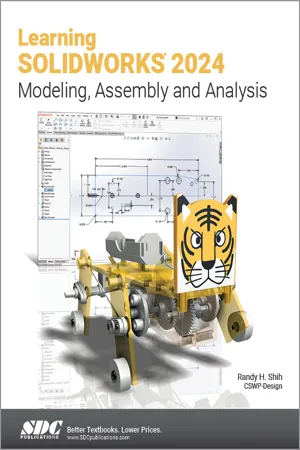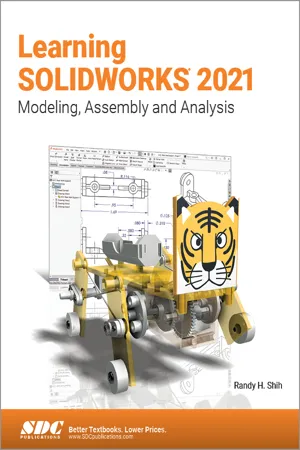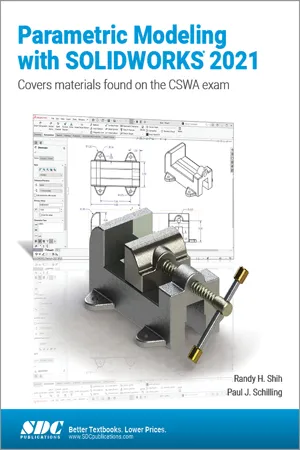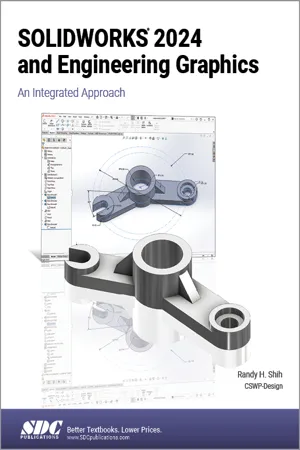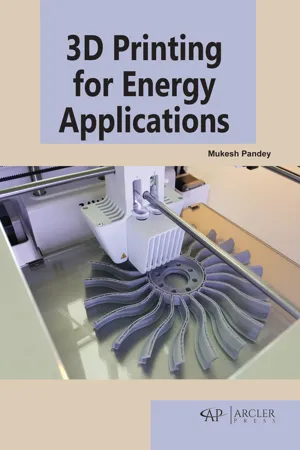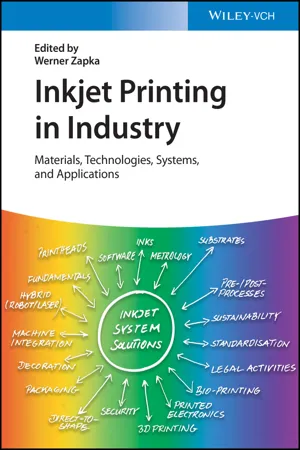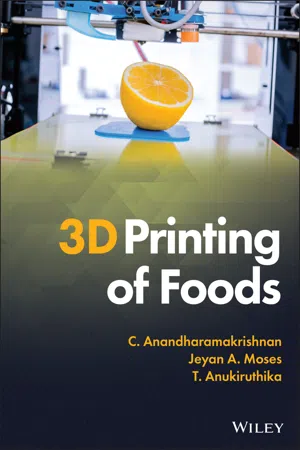Technology & Engineering
3D Printing
3D printing is a manufacturing process that creates three-dimensional objects by layering materials based on a digital model. It allows for the production of complex and customized designs, making it valuable in various industries such as aerospace, healthcare, and automotive. This technology has the potential to revolutionize traditional manufacturing methods by offering greater flexibility and efficiency.
Written by Perlego with AI-assistance
Related key terms
1 of 5
9 Key excerpts on "3D Printing"
- eBook - PDF
Learning SOLIDWORKS 2024
Modeling, Assembly and Analysis
- Randy H. Shih(Author)
- 2024(Publication Date)
- SDC Publications(Publisher)
The 3D Printing technology provides a way to create parts with complex geometric shapes quite easily using thin layers. The traditional subtractive manufacturing can also be quite wasteful as excess materials are cut and removed from large stock blocks, while the 3D Printing process only uses the material needed for the parts. 3D Printing is an enabling technology that encourages and Introduction to 3D Printing 13-3 drives innovation with unprecedented design freedom while being a tooling-less process that reduces costs and lead times. The relatively fast turnaround time also makes 3D Printing ideal for prototyping. Components with intricate geometry and complex features can also be designed specifically for 3D Printing to avoid complicated assembly requirements. 3D Printing is also an energy efficient technology that can provide better environmental friendliness in terms of the manufacturing process itself and the type of materials used for the product. There are quite a few different techniques to 3D print an object. 3D Printing brings together two fundamental innovations: the manipulation of objects in the digital format and the manufacturing of objects by addition of material in thin layers. The term 3D-printing originally refers only to the smaller 3D printers with movable print heads similar to an inkjet printer. Today, the term 3D-printing is used interchangeably with Additive Manufacturing, as both refer to the technology of creating parts through the process of adding/forming thin layers of materials. Development of 3D Printing Technologies The earliest 3D Printing technology was first invented in the 1980s; at that time it was generally called Rapid Prototyping (RP) technology. This is because the process was originally conceived as a fast and time-effective method for creating prototypes for product development in industry. - eBook - PDF
Learning SOLIDWORKS 2021
Modeling, Assembly and Analysis
- Randy H. Shih(Author)
- 2021(Publication Date)
- SDC Publications(Publisher)
The 3D Printing technology provides a way to create parts with complex geometric shapes quite easily using thin layers. The traditional subtractive manufacturing can also be quite wasteful as excess materials are cut and removed from large stock blocks, while the 3D Printing process only uses the material needed for the parts. 3D Printing is an enabling technology that encourages and Introduction to 3D Printing 13-3 drives innovation with unprecedented design freedom while being a tooling-less process that reduces costs and lead times. The relatively fast turnaround time also makes 3D Printing ideal for prototyping. Components with intricate geometry and complex features can also be designed specifically for 3D Printing to avoid complicated assembly requirements. 3D Printing is also an energy efficient technology that can provide better environmental friendliness in terms of the manufacturing process itself and the type of materials used for the product. There are quite a few different techniques to 3D print an object. 3D Printing brings together two fundamental innovations: the manipulation of objects in the digital format and the manufacturing of objects by addition of material in thin layers. The term 3D-printing originally referred only to the smaller 3D printers with moveable print heads similar to an inkjet printer. Today, the term 3D-printing is used interchangeably with Additive Manufacturing, as both refer to the technology of creating parts through the process of adding/forming thin layers of materials. Development of 3D Printing Technologies The earliest 3D Printing technology was first invented in the 1980s; at that time it was generally called Rapid Prototyping (RP) technology. This is because the process was originally conceived as a fast and time-effective method for creating prototypes for product development in industry. - eBook - PDF
- Paul J. Schilling, Randy H. Shih(Authors)
- 2021(Publication Date)
- SDC Publications(Publisher)
The 3D Printing technology provides a way to create parts with complex geometric shapes quite easily using thin layers. The traditional subtractive manufacturing can also be quite wasteful as excess materials are cut and removed from large stock blocks, while the 3D Printing process basically uses only the material needed for the parts. 3D Printing is an enabling technology that encourages and drives innovation with unprecedented Introduction to 3D Printing 10-3 design freedom while being a tooling-less process that reduces costs and lead times. The relatively fast turnaround time also makes 3D Printing ideal for prototyping. Components with intricate geometry and complex features can also be designed specifically for 3D Printing to avoid complicated assembly requirements. 3D Printing is also an energy efficient technology that can provide better environmental friendliness in terms of the manufacturing process itself and the type of materials used for the product. There are quite a few different techniques to 3D print an object. 3D Printing brings together two fundamental innovations: the manipulation of objects in the digital format and the manufacturing of objects by addition of material in thin layers. The term 3D-printing originally referred only to the smaller 3D printers with moveable print heads similar to an inkjet printer. Today, the term 3D-printing is used interchangeably with Additive Manufacturing, as both refer to the technology of creating parts through the process of adding/forming thin layers of materials. Development of 3D Printing Technologies The earliest 3D Printing technology was first invented in the 1980s; at that time it was generally called Rapid Prototyping (RP) technology. This is because the process was originally conceived as a fast and time-effective method for creating prototypes for product development in industry. - eBook - PDF
Parametric Modeling with Creo Parametric 10.0
An Introduction to Creo Parametric 10.0
- Randy H. Shih(Author)
- 2023(Publication Date)
- SDC Publications(Publisher)
The 3D Printing technology provides a way to create parts with complex geometric shapes quite easily using thin layers. The traditional subtractive manufacturing can also be quite wasteful as excess materials are cut and removed from large stock blocks, while the 3D Printing process basically uses only the material needed for the parts. 3D Printing is an enabling technology that encourages and drives innovation with unprecedented Introduction to 3D Printing 7-3 design freedom while being a tooling-less process that reduces costs and lead times. The relatively fast turnaround time also makes 3D Printing ideal for prototyping. Components with intricate geometry and complex features can also be designed specifically for 3D Printing to avoid complicated assembly requirements. 3D Printing is also an energy efficient technology that can provide better environmental friendliness in terms of the manufacturing process itself and the type of materials used for the product. There are quite a few different techniques to 3D print an object. 3D Printing brings together two fundamental innovations: the manipulation of objects in the digital format and the manufacturing of objects by addition of material in thin layers. The term 3D-printing originally referred only to the smaller 3D printers with moveable print heads similar to an inkjet printer. Today, the term 3D-printing is used interchangeably with Additive Manufacturing, as both refer to the technology of creating parts through the process of adding/forming thin layers of materials. Development of 3D Printing Technologies The earliest 3D Printing technology was first invented in the 1980s; at that time it was generally called Rapid Prototyping (RP) technology. This is because the process was originally conceived as a fast and time-effective method for creating prototypes for product development in industry. - eBook - PDF
SOLIDWORKS 2024 and Engineering Graphics
An Integrated Approach
- Randy H. Shih(Author)
- 2024(Publication Date)
- SDC Publications(Publisher)
One way to think about 3D Printing is the additive process is really performing “2D printing over and over again.” A number of limitations exist to the traditional manufacturing processes, which has been based on human labor and made by hand ideology, including expensive tooling, designing of fixtures, and the assembly of parts. The 3D Printing technology provides a way to create parts with complex geometric shapes quite easily using thin layers. The traditional subtractive manufacturing can also be quite wasteful as excess materials are cut and removed from large stock blocks, while the 3D Printing process only uses the material needed for the parts. 3D Printing is an enabling technology that encourages and Introduction to 3D Printing 13-3 drives innovation with unprecedented design freedom while being a tooling-less process that reduces costs and lead times. The relatively fast turnaround time also makes 3D Printing ideal for prototyping. Components with intricate geometry and complex features can also be designed specifically for 3D Printing to avoid complicated assembly requirements. 3D Printing is also an energy efficient technology that can provide better environmental friendliness in terms of the manufacturing process itself and the type of materials used for the product. There are quite a few different techniques to 3D print an object. 3D Printing brings together two fundamental innovations: the manipulation of objects in the digital format and the manufacturing of objects by addition of material in thin layers. The term 3D-printing originally refers only to the smaller 3D printers with movable print heads similar to an inkjet printer. Today, the term 3D-printing is used interchangeably with Additive Manufacturing, as both refer to the technology of creating parts through the process of adding/forming thin layers of materials. - eBook - PDF
- Mukesh Pandey(Author)
- 2023(Publication Date)
- Arcler Press(Publisher)
INTRODUCTION 3D Printing TECHNOLOGY 1 CONTENTS 1.1 Introduction ........................................................................................ 2 1.2 Additive Manufacturing and its Types ................................................... 4 1.3 Ingredients Utilized for Digital Fabrication Technology in Fabricating Industry ...................................................................... 8 1.4 Digital Fabrication’s Usage in Manufacturing Technology ................. 13 References .............................................................................................. 19 CHAPTER 3D Printing for Energy Applications 2 1.1 INTRODUCTION Through the sequential adding of supplies, physical items from a geometric depiction are fashioned by additive manufacturing or 3D Printing, also known as digital fabrication technology. High tech which is emerging quite quickly is 3D Printing technology. It is high-tech which is extensively utilized everywhere. In the industry of locomotives, in healthcare, aviation industry, and agriculture for open-source designs manufacture, digital fabrication technology is utilized for bulk customization progressively (Saheb & Kumar, 2020). From the prototype of a CAD (computer-aided design), an item’s print can be taken in layers by the removal of material directly through additive manufacturing. In the industry of manufacturing, the constituents employed for additive manufacturing, its use, and its categories are presented in the paper. Through successively adding ingredients, physical items can be formed through geometric depiction by 3D Printing (Shahrubudin et al., 2020). In the current time, remarkable growth has been delegated to this 3D procedure. Charles Hull initially marketed this additive manufacturing in 1980 (Gartner et al., 2015). - eBook - PDF
Inkjet Printing in Industry
Materials, Technologies, Systems, and Applications, 3 Volumes
- Werner Zapka(Author)
- 2022(Publication Date)
- Wiley-VCH(Publisher)
1351 Part XIII 3D Printing 1353 59 3D Printing/Additive Manufacturing Neil Hopkinson 1 and Patrick J. Smith 2 1 Xaar 3D Ltd, 5-6 William Lee Buildings, Science and Technology Park, Nottingham, NG7 2RQ, UK 2 Laboratory of Applied Inkjet Printing, D 03, Royal Exchange Manufacturing Building, 64 Garden Street, Sheffield, S1 4BJ, England 59.1 Overview of Additive Manufacturing Additive manufacturing (AM) is defined as a process of joining materials to make objects from 3D model data, usually layer upon layer, as opposed to subtractive manufacturing methodologies (where material is removed from a larger block or form, or, as with injection molding, the material is added to a shaped container) [1]. AM technologies are frequently sub-divided according to the feedstock material used in the process, with the main sub-divisions being: ● Powder ● Filament ● Liquid photopolymer However, it should be appreciated that other feedstock material types such as sheet material, including paper, and welding rod are also employed in some processes. Inkjet technology is employed in powder-based processes and in liquid photopoly- mer processes and these are described in more detail in this chapter. 59.2 Inkjet As a Commercially Attractive Enabler in Industrial 3D Printing/Additive Manufacturing Inkjet technology is fast emerging as the technology of choice to meet a number of increasingly complex and valuable industrial opportunities, taking the technology beyond its original roots in graphics to a myriad of applications from printed elec- tronics to solar panels. Similarly, 3D Printing/Additive Manufacturing technology is also growing fast and expanding beyond its original use for prototyping to be the technology of choice to deliver end use products for a vast range of applications from aerospace to healthcare. Inkjet Printing in Industry: Materials, Technologies, Systems, and Applications, First Edition. Edited by Werner Zapka. © 2022 WILEY-VCH GmbH. Published 2022 by WILEY-VCH GmbH. - eBook - PDF
- C. Anandharamakrishnan, Jeyan A. Moses, T. Anukiruthika(Authors)
- 2022(Publication Date)
- Wiley(Publisher)
1 Introduction to 3D Printing Technology CHAPTER MENU 1.1 Introduction, 1 1.2 Digital Manufacturing: From Rapid Prototyping to Rapid Manufacturing, 3 1.3 Milestones in 3D Printing Technology, 4 1.4 Different Historical Eras in 3D Printing, 5 1.4.1 Ancient Age, 5 1.4.2 Middle Age, 5 1.4.3 Modern Age, 5 1.5 Prospects of 3D Food Printing, 6 1.6 Design Considerations of 3D Printer, 7 1.6.1 Printer Configurations, 7 1.6.2 Components of a Typical 3D Printer, 10 1.6.2.1 Enclosure, Build Plate, and Guide Rails, 10 1.6.2.2 Mechanical Drive Systems, 12 1.6.2.3 Microprocessor Controlling System, 12 1.7 Software Requirements and Hardware Integration, 13 1.8 Designing, Digital Imaging, and Modelling, 16 1.8.1 Image Acquisition, Processing, and Modelling, 16 1.8.2 Repairing and Post-Processing, 20 1.9 Food Printing Platforms, 21 1.9.1 Universal Platform, 21 1.9.2 User-Defined Platform, 21 1.9.3 Applicability of User Interface Systems, 23 1.10 Comparison Between Food 3D Printing and Robotic Food Manufacturing, 23 1.11 Conclusion, 24 1.1 Introduction Three-dimensional (3D) printing appears to be a revolutionizing solid-free fabrication (SFF) technique that grabs attention in recent years because of its inherent potential to transform virtual ideas into reality. Any manufacturing process involves a series of steps in converting the raw material into finished products. Manufacturing processes are classified as the addi-tive process, subtractive process, formative process, and joining process (Bandyopadhyay and Heer 2018). As the name implies additive process involves the formation of an object by the addition of the material in a layered manner one above the other. On the other hand, 1 3D Printing of Foods , First Edition. C. Anandharamakrishnan, Jeyan A. Moses, and T. Anukiruthika. © 2022 John Wiley & Sons Ltd. Published 2022 by John Wiley & Sons Ltd. the removal of the material by sculpturing an object out of the solid raw material is referred to as a subtractive process. - eBook - PDF
Smart Manufacturing
The Lean Six Sigma Way
- Anthony Tarantino(Author)
- 2022(Publication Date)
- Wiley(Publisher)
267 Introduction Additive manufacturing (AM) is a technology used to create an object from a computer-aided design (CAD) model by adding materials in a layer-by-layer manner (Ngo et al. 2018). This chapter aims to provide a brief introduction to the basic concepts of additive manufacturing, the history and current state of this technology, and a description of the methods, materials, and application of this technology in different industries. The first commercialized system for additive manufacturing, known as the stereolithogra- phy apparatus (SLA), was developed by Charles Hull in 1986 (Ngo et al. 2018). This system incorporated an ultraviolet (UV) laser to solidify a photo-curable liquid polymer (Bose and Bandyopadhyay 2019). Remarkable developments such as fused deposition modeling (FDM), inkjet printing, and other techniques have been made since the advent of SLA (S. H. Huang et al. 2013). Rapid prototyping (RP) and other terms had been used to represent the various AM processes until the American Society for Testing and Materials (ASTM) Technical Committee agreed on the new term additive manufacturing (ASTM International 2012). RP was initially regarded as a process to fabricate a model quickly for the purpose of visualizing a design or creating a rep- resentative example of a final product, and this process has helped engineers to create and analyze the designs they have in mind (Wong and Hernandez 2012). However, since the advent of significant advancements in AM processes, materials, and applications, AM technology is being used not only for the fabrication of prototypes but also for creating final products (Ngo et al. 2018; Vaezi et al. 2013). 3D Printing and Additive Manufacturing Bahareh Tavousi Tabatabaei, Rui Huang, and Jae-Won Choi CHAPTER 12
Index pages curate the most relevant extracts from our library of academic textbooks. They’ve been created using an in-house natural language model (NLM), each adding context and meaning to key research topics.
